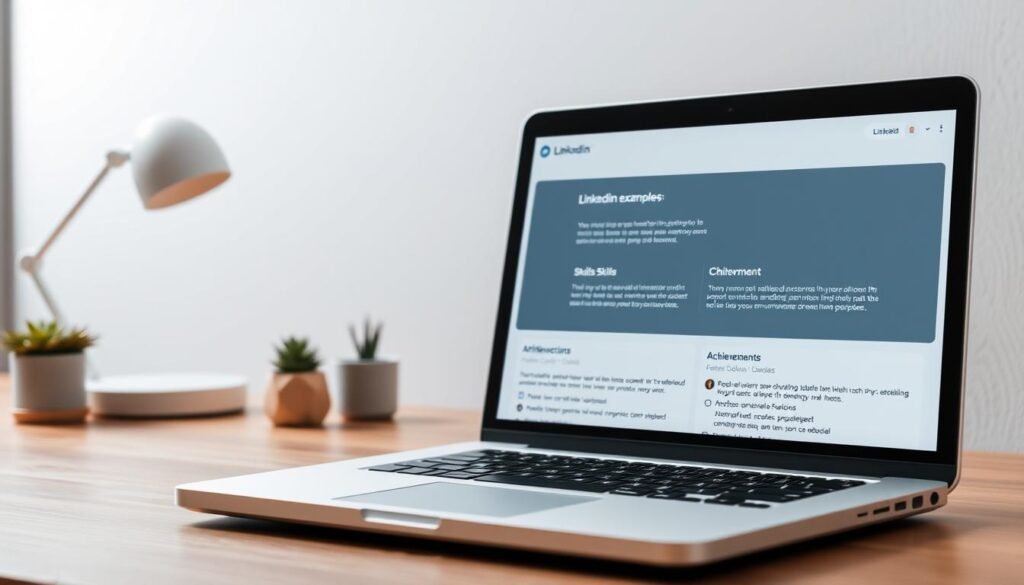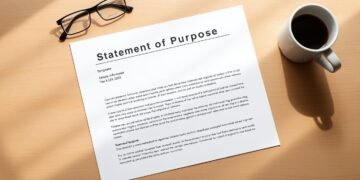Did you know that 80% of B2B leads come from professional networking platforms? Your profile is often the first impression you make, and it’s crucial to get it right. Whether you’re a student, a career switcher, or a seasoned professional, a well-crafted summary can set you apart.
With a 2,600-character limit, your summary sits in a prime spot on your profile. It’s your chance to showcase your skills, experience, and personality. A tailored summary not only boosts your visibility but also positions you as a thought leader in your industry.
This article dives into industry-specific templates and strategies to optimize your profile. Learn how to create a summary that grabs attention and drives action. Ready to elevate your professional presence? Let’s get started.
Key Takeaways
- Tailored summaries are essential for different career stages.
- Your summary has a 2,600-character limit and is prominently placed.
- 80% of B2B leads originate from professional networking platforms.
- Optimizing your profile enhances social selling and thought leadership.
- Industry-specific templates can help you stand out.
Why a LinkedIn Summary is Essential for Your Profile

Your professional profile is more than just a resume—it’s your digital handshake. In a world where 49% of B2B buyers research sellers on professional platforms first, your summary is often the first thing they see. It’s your chance to make a lasting impression.
The Role of a Profile Summary in Professional Branding
A well-written summary showcases your skills and experience while reflecting your personality. It’s not just about listing achievements; it’s about telling your story. For example, Justin Welsh’s career narrative effectively highlights his journey, making his profile stand out.
Optimized profiles are proven to drive results. Studies show that professionals with complete profiles achieve 51% higher quota attainment. This underscores the importance of crafting a summary that resonates with your audience.
How a Strong Summary Can Attract Opportunities
A compelling summary can open doors to new opportunities. Shradha Sharma’s passion-driven bio, for instance, increased engagement and attracted meaningful connections. Similarly, Darrell Evans’ pain-point-focused approach demonstrates how addressing your audience’s needs can make your profile more impactful.
Remember, 50% of buyers avoid reps with incomplete profiles. A strong summary not only builds trust but also positions you as a thought leader in your field. It’s your chance to shine and attract the right opportunities.
Key Elements of a Compelling LinkedIn Summary

Standing out in a competitive landscape starts with a compelling narrative. Your profile is more than a list of experiences—it’s a story that highlights your skills and delivers value to your audience. To make an impact, focus on three essential elements: authentic storytelling, measurable results, and a clear call to action.
Authentic Storytelling
Authenticity is key to connecting with your audience. Share experiences that reflect your journey, like Damilare Odueso’s childhood anecdote that opened his profile. Ross Pomerantz’s humor-infused tech summary is another great example. These approaches humanize your profile and make it memorable.
Highlighting Measurable Results
Numbers speak louder than words. Profiles with metrics see 40% more views, and 62% of recruiters prioritize summaries with quantifiable achievements. Use the formula: “Achieved [X] result using [Y] skill for [Z] client.” Fernando Silva’s results-driven approach is a perfect example of this strategy.
Including a Clear Call to Action
End your summary with a strong call action. Whether it’s inviting connections to collaborate or explore your portfolio, a clear CTA guides your audience on the next steps. The “Before-After-Bridge” narrative structure is an effective way to lead readers toward your desired action.
LinkedIn Summary Template: A Step-by-Step Guide
Crafting a standout professional narrative begins with a clear structure. A well-organized profile not only grabs attention but also keeps readers engaged. Here’s how to structure your summary effectively and write in a conversational tone.
How to Structure Your Summary Effectively
Start with a strong hook to capture attention. For example, Gijo Mathew’s technical summary simplifies complex ideas for general audiences. Next, outline your mission or career goals. This sets the stage for your story.
Highlight your skills and achievements using bullet points. Profiles with bullet points get 30% more reads. Finally, include a clear call to action (CTA). This guides readers on the next steps, whether it’s connecting or exploring your portfolio.
Tips for Writing in a Conversational Tone
First-person narratives increase connection requests by 25%. Write as if you’re speaking directly to the reader. Avoid overly formal language and focus on clarity. For instance, Darrell Evans’ profile uses a conversational tone to address pain points effectively.
Use white space to break up paragraphs. This makes your summary easier to read, especially on mobile devices. Always preview your profile on mobile to ensure it looks polished and professional.
LinkedIn Summary Examples for Students
For students, a well-crafted professional narrative can be the key to unlocking opportunities. With 60% of entry-level hires coming through professional platforms, your profile needs to stand out. Whether you’re a recent graduate or have no formal work experience, your summary can highlight your potential.
Student profiles that mention class projects see 35% more recruiter interest. This shows the importance of showcasing academic achievements and extracurricular activities. Let’s explore how to create a compelling narrative tailored to your stage.
Template for Recent Graduates
Recent graduates often struggle to translate academic experiences into professional value. Start by highlighting your skills and achievements. For example, a computer science student could focus on leadership roles in coding clubs or hackathons.
Include measurable results, like “Led a team of 5 to develop a mobile app that improved campus navigation.” This demonstrates your ability to apply classroom knowledge to real-world challenges. End with a clear career goal, such as “Seeking opportunities in software development to innovate and solve complex problems.”
Example for Students with No Work Experience
If you lack formal work experience, focus on transferable skills from volunteer work or part-time jobs. For instance, a student who babysat could highlight organizational and communication skills gained from managing children’s schedules.
Another example is a travel blogger transitioning to journalism. Emphasize storytelling and research skills developed through blogging. Use phrases like “Crafted engaging travel content that reached 10,000 monthly readers.” This shows initiative and creativity, even without traditional work roles.
By integrating academic achievements, club leadership, and volunteer experience, you can create a profile that resonates with recruiters and opens doors to your future career.
LinkedIn Summary Examples for Career Switchers
Switching careers can feel daunting, but it’s also an opportunity to reinvent yourself. With 68% of hiring managers valuing transferable skills, your profile can bridge the gap between your past and future roles. Let’s explore how to make this transition seamless.
How to Transition Skills into a New Industry
Start by identifying your transferable skills. For example, a sales professional moving into HR can highlight negotiation and relationship-building abilities. Quantify your achievements, like “Trained 50+ employees on conflict resolution, improving team productivity by 20%.”
Use a Skills Translation Table to map your old and new industries. This helps recruiters see how your background aligns with their needs. Chris NeJame’s systems-thinking approach is a great example of showcasing adaptability.
Example for Professionals Changing Careers
Take Ryan Gunn’s problem-solution framework. He transitioned from retail management to real estate by emphasizing leadership and customer service. His profile highlighted measurable results, like “Increased store revenue by 15% through strategic planning.”
Another example is a retail manager becoming a real estate agent. By focusing on client management and organizational skills, they positioned themselves as a trusted advisor in a new field.
Whether you’re moving from one business to another or exploring a completely different way of working, your profile can tell a compelling story of growth and adaptability.
LinkedIn Summary Examples for Experienced Professionals
For seasoned professionals, a well-crafted profile can be a game-changer in attracting opportunities. With executives receiving 2x more InMails when using metrics-driven summaries, it’s clear that a strategic approach pays off. Whether you’re a senior-level executive or have decades of experience, your profile should reflect your expertise and achievements.
Template for Senior-Level Executives
Senior-level executives should focus on measurable results and leadership impact. For example, highlight team growth statistics like “Expanded a team from 5 to 20 members, driving a 30% increase in productivity.” This demonstrates your ability to scale operations effectively.
Include board memberships or advisory roles to showcase your influence. Mentioning Fortune 500 clients can also add credibility. A strong narrative framework, such as crisis management stories, can further highlight your problem-solving skills.
Example for Professionals with Extensive Experience
Professionals with over 15 years of experience can use international travel or global projects as a hook. For instance, “Managed product launches across 10 countries, increasing market share by 25%.” This shows your adaptability and global perspective.
Highlight key achievements like “Led a $10M project, delivering it 3 months ahead of schedule.” Such metrics provide concrete evidence of your capabilities. End with a forward-looking statement, such as “Seeking to leverage 20+ years of experience to drive innovation in emerging markets.”
How to Tailor Your LinkedIn Summary for Different Industries
Tailoring your professional narrative to specific industries can significantly boost your visibility and relevance. Each field has unique expectations, and aligning your profile with these can make a lasting impression. Let’s explore how to adapt your approach for tech, sales, and marketing, along with essential keywords to include.
Adapting Your Summary for Tech, Sales, and Marketing
In the tech industry, hard skills are crucial. Profiles that mention technical expertise like “cloud migration” or “scalability” see 5x more engagement. Highlight certifications or tools you’ve mastered, such as AWS or Python.
For sales professionals, focus on metrics. Phrases like “overachieved quota by 150%” demonstrate your impact. Include specific achievements, such as “Increased regional revenue by 25% in Q3.”
In marketing, showcase your familiarity with platforms like HubSpot or Google Analytics. Mention campaigns you’ve led and their results, such as “Boosted website traffic by 40% through SEO optimization.”
Industry-Specific Keywords to Include
Different fields require distinct language. In healthcare, emphasize empathy and patient care. For finance, use precise terms like “portfolio management” or “risk assessment.”
For SaaS roles, include keywords like “API integration” or “customer retention.” Legal profiles should highlight compliance-focused terms, such as “regulatory adherence.”
Creative fields, like design or writing, benefit from a conversational tone. Use phrases like “crafted compelling narratives” or “designed user-centric interfaces.” Tailoring your language to your business niche ensures your profile resonates with the right audience.
The Importance of Keywords in Your LinkedIn Summary
In today’s competitive job market, strategically using keywords can make your profile stand out. These terms help recruiters and algorithms find you more easily. By optimizing your content, you increase your chances of being noticed.
How to Identify Relevant Keywords
Start by analyzing job descriptions in your field. Tools like SEMrush can help identify trending terms. Combine this with LinkedIn’s search feature to see what professionals in your industry are using.
Extract skills and phrases that appear frequently. Avoid overused terms like “motivated” or “team player.” Instead, focus on specific, industry-relevant language that highlights your expertise.
Optimizing Your Profile for Search
LinkedIn’s algorithm prioritizes the first 200 characters of your profile. Place your most important keywords here to boost visibility. Profiles with 10+ skills get 13x more views, so ensure your skills section is complete.
Hidden areas like your headline and experience descriptions are also key. Use these spaces to naturally incorporate information that aligns with your career goals. This approach helps you rank higher in recruiter searches.
How to Showcase Your Personality in Your LinkedIn Summary
Adding a personal touch to your profile can make it more relatable and engaging. While professionalism is key, letting your personality shine through can create a memorable impression. Profiles that include hobbies or personal interests receive 28% more connection requests.
Balancing Professionalism with Personal Flair
Striking the right tone is essential. For example, Matt Redler’s mention of being a tennis enthusiast adds a human element to his tech-focused profile. Similarly, a sales executive who integrates their passion for baking demonstrates creativity and dedication.
Volunteer work is another great way to showcase your values. Highlighting community involvement can resonate with like-minded people. However, avoid over-sharing. Focus on details that align with your professional brand.
Examples of Engaging and Personable Summaries
Consider the “Weekend vs. Weekday” framework. This approach contrasts your professional expertise with personal hobbies, creating a well-rounded narrative. For instance, “By day, I lead marketing campaigns; by weekend, I’m an avid hiker exploring national parks.”
Another example is a finance professional who mentions their love for chess. This subtly highlights strategic thinking while adding a personal touch. By weaving in your interests, you create a profile that’s both professional and personable.
Common Mistakes to Avoid in Your LinkedIn Summary
Crafting a professional narrative requires attention to detail and avoiding common pitfalls. These mistakes can weaken your profile and leave a poor impression on potential connections or employers. Let’s explore two critical errors and how to fix them.
Overloading with Jargon
Using too much industry-specific language can alienate readers. For example, a jargon-heavy phrase like “leveraged synergistic paradigms” might confuse rather than impress. Instead, simplify your language to make your profile accessible to a broader audience.
Spell out acronyms the first time you use them. For instance, write “Search Engine Optimization (SEO)” before abbreviating it. This ensures clarity and helps readers understand your expertise without getting lost in technical terms.
Failing to Proofread
Spelling and grammar errors can undermine your credibility. Studies show that 43% of profiles contain such mistakes. Always proofread your content before publishing. Tools like Grammarly or Hemingway can help catch errors and improve readability.
Check your profile on mobile devices to ensure proper formatting. Voice-to-text editing is another useful trick—listening to your summary can help you spot awkward phrasing or inconsistencies.
By avoiding these common errors, you can create a polished and professional profile that leaves a lasting impression.
How to Use Metrics to Strengthen Your LinkedIn Summary
Metrics are the backbone of a compelling professional narrative. They provide concrete evidence of your skills and achievements, making your profile stand out. By incorporating quantifiable results, you can demonstrate your impact and credibility effectively.
Incorporating Quantifiable Achievements
Phrases like “Increased X by Y%” boost credibility by 67%. For example, “Improved team productivity by 25% through streamlined processes” shows measurable success. Even in non-sales roles, such as HR, you can highlight metrics like “Reduced employee turnover by 15%.”
When framing achievements, ensure compliance with non-disclosure agreements. Use A/B tested results to showcase your ability to analyze and improve outcomes. For non-profits, focus on impact measurement, such as “Raised $50,000 for community programs.”
Examples of Using Data Effectively
Service roles can benefit from ROI calculations. For instance, “Generated a 300% return on investment for clients through strategic planning” highlights your value. Similarly, “Increased website traffic by 40% using SEO optimization” demonstrates tangible results.
In the sales industry, metrics like “Exceeded quarterly targets by 150%” are highly effective. For tech roles, mention specific tools or certifications, such as “Implemented cloud solutions that reduced costs by 20%.”
By leveraging data, you can create a profile that not only showcases your experience but also attracts the right opportunities. Metrics make your story compelling and actionable.
The Role of a Call to Action in Your LinkedIn Summary
A strong call action can transform your profile from passive to proactive. It’s not just about sharing your story—it’s about guiding your audience toward the next step. Whether you’re seeking a new opportunity or building your team, a well-crafted CTA can make all the difference.
How to Craft an Effective CTA
Generic phrases like “DM me” lack impact. Instead, be specific. For example, “Book a discovery call to discuss how I can help your team grow” is far more compelling. Studies show that CTAs with specific methods increase response rates by 34%.
Tailor your CTA to your goals. If you’re consulting, include a link to your calendar. For job seekers, invite recruiters to review your portfolio. Integrating tools like Calendly or Google Calendar simplifies the process for your audience.
Examples of Strong CTAs for Different Goals
For podcast hosts, try: “Interested in having me as a guest? Let’s discuss topics that resonate with your audience.” This invites collaboration while showcasing your expertise.
Newsletter creators can use: “Subscribe to my weekly insights on industry trends and actionable tips.” This highlights value and encourages sign-ups.
Job seekers might say: “Let’s connect to explore how my skills align with your company’s vision.” This positions you as a proactive candidate ready to contribute.
By crafting a clear and specific call action, you guide your audience toward meaningful connection and engagement.
How to Update Your LinkedIn Summary Regularly
Keeping your professional profile updated is crucial for staying relevant in today’s fast-paced job market. Quarterly updates lead to 22% more profile traffic, making it essential to refresh your content regularly. Whether you’ve gained new skills, achieved milestones, or shifted career goals, your profile should reflect these changes.
When and Why to Refresh Your Summary
Refresh your profile after significant career events, such as promotions, role changes, or content milestones. For consultants, seasonal variations in your summary can highlight your adaptability. Regular updates ensure your profile remains accurate and aligned with your current experience and goals.
Using version control naming conventions can help you track changes over the years. This approach not only keeps your profile organized but also demonstrates attention to detail—a valuable trait in any management role.
Tips for Keeping Your Summary Current
Integrate tools like Google Analytics to track profile performance. This provides valuable information on what’s working and what needs improvement. Additionally, ensure your profile is compatible with LinkedIn Creator Mode, which can enhance your visibility and engagement.
Set alerts for key career milestones to prompt timely updates. For example, after completing a major project or earning a certification, update your profile to reflect these achievements. This proactive approach keeps your profile fresh and relevant, attracting more opportunities.
LinkedIn Summary Templates for Different Career Stages
Your professional journey deserves a narrative that evolves with your career. Whether you’re just starting out or advancing in your field, a tailored profile can highlight your unique strengths and goals. Let’s explore templates designed for entry-level and mid-career professionals.
Template for Entry-Level Professionals
For those new to the workforce, focus on transferable skills and enthusiasm. Use this plug-and-play template:
“[Your Name] is a [Job Title] with a passion for [Industry/Field]. With a background in [Relevant Education or Training], I bring [Key Skills] to the table. My experience in [Class Projects/Internships] has equipped me with [Specific Abilities]. I’m eager to contribute to [Company/Team Goals] and grow in my career.”
Incorporate measurable achievements, like “Led a team of 5 to complete a [Project], resulting in [Outcome].” This demonstrates your potential and readiness for new challenges.
Template for Mid-Career Professionals
Mid-career professionals should emphasize leadership and results. Here’s a framework:
“[Your Name] is a seasoned [Job Title] with [X] years of experience in [Industry]. I specialize in [Key Expertise], having successfully [Achievement]. My leadership in [Project/Team] led to [Quantifiable Result]. Currently, I’m focused on [Current Goal] and exploring opportunities to [Next Step].”
Highlight certifications or upskilling efforts, such as “Certified in [Skill], I’ve enhanced my ability to [Outcome].” If you have a side hustle, mention it to showcase versatility: “Outside of my primary role, I manage [Side Hustle], which has honed my [Transferable Skill].”
Use promotion-ready language like “Seeking to leverage my experience to drive [Impact] in a leadership role.” This positions you as a forward-thinking professional ready for advancement.
How to Use Your LinkedIn Summary to Build Your Network
Building meaningful professional relationships starts with a profile that invites engagement. Your summary isn’t just a career snapshot—it’s a tool to attract the right people and opportunities. Studies show personalized requests have over 50% higher acceptance rates. Here’s how to optimize your narrative for networking success.
Strategies for Connecting with Industry Professionals
Reference alumni groups or events to create instant rapport. For example: “As a [University] grad, I’m passionate about connecting with fellow alumni in [Industry].” This taps into shared experiences.
Adapt your summary for conferences or webinars. Mentioning “Excited to attend [Event] to discuss [Topic]” encourages in-person connections.
Tease mutual contacts subtly: “Collaborated with teams at [Company]—let’s explore synergies.” This sparks curiosity and trust.
Examples of Summaries That Attract Connections
For content creators: “Let’s collaborate on thought leadership pieces—DM me your latest project.” This invites partnership.
Mentorship seekers: “Eager to learn from seasoned [Role] professionals. Coffee chats welcome!” This positions you as proactive.
Highlight shared interests: “When I’m not optimizing supply chains, I hike trails—connect if you love the outdoors too.” This humanizes your profile.
By tailoring your summary to foster connection, you transform your profile into a gateway for your professional network.
Conclusion: Crafting a LinkedIn Summary That Stands Out
Your professional profile is more than a resume—it’s your digital handshake. To create a lasting impression, focus on the 5-star formula: Story, Skills, Proof, Personality, and a clear Call to Action. This approach ensures your profile stands out and drives success.
Mobile optimization is crucial. Ensure your profile is easy to read on all devices. Remember, the 2,600-character limit isn’t for repeating your resume—it’s for showcasing your unique value.
Experiment with A/B testing using platform analytics to refine your content. Tools like Nutshell CRM can help integrate your efforts seamlessly. By following these steps, you’ll unlock new opportunities and build a profile that truly represents you.
FAQ
Why is a professional summary important for my profile?
A professional summary is crucial for branding and showcasing your expertise. It helps attract opportunities by giving a snapshot of your skills and career goals.
What are the key elements of a compelling summary?
A strong summary includes authentic storytelling, measurable results, and a clear call to action. These elements make your profile stand out.
How can I structure my summary effectively?
Start with a strong opening, highlight your achievements, and end with a call to action. Use a conversational tone to engage readers.
What should students include in their summaries?
Students should focus on academic achievements, internships, and transferable skills. Even without work experience, showcasing passion and potential is key.
How can career switchers transition skills into a new industry?
Highlight transferable skills and relevant accomplishments. Emphasize your adaptability and enthusiasm for the new field.
What should experienced professionals focus on in their summaries?
Senior professionals should emphasize leadership, measurable results, and industry expertise. Tailor your summary to reflect your career journey.
How do I adapt my summary for different industries?
Use industry-specific keywords and focus on relevant skills. Customize your summary to align with the expectations of your target field.
Why are keywords important in my summary?
Keywords optimize your profile for search, making it easier for recruiters and professionals to find you. Use terms relevant to your industry and role.
How can I showcase my personality in my summary?
Balance professionalism with personal flair. Share your passions, values, and unique qualities to make your profile memorable.
What are common mistakes to avoid in my summary?
Avoid overloading with jargon, being too vague, or failing to proofread. Keep it clear, concise, and error-free.
How can I use metrics to strengthen my summary?
Include quantifiable achievements, such as revenue growth or project success rates. Data adds credibility and impact to your profile.
What role does a call to action play in my summary?
A call to action encourages engagement, whether it’s connecting, exploring opportunities, or reaching out for collaboration.
How often should I update my summary?
Refresh your summary regularly, especially after career milestones or role changes. Keeping it current ensures it reflects your latest achievements.
What templates work for different career stages?
Entry-level professionals should focus on skills and potential, while mid-career professionals highlight experience and leadership. Tailor your template to your stage.
How can I use my summary to build my network?
Craft a summary that invites connections. Highlight your interests, goals, and willingness to collaborate with industry professionals.





